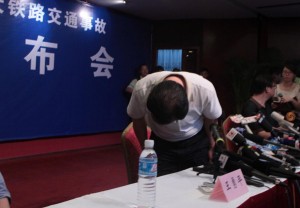The Chinese media has been pressing for information relating to why didn’t the D301 train stop in time and instead rear-ended the D3115. In the latest press conference over the collision, Ministry of Rail spokesperson Wang Yongping (王勇平) informed the press that the ‘blackbox’ for the D301 train has been recovered and experts are investigating the cause of the crash. So far, 38 people were confirmed dead with more than 200 injured.
CCTV has also reported the repairs to the rail road is done and rail traffic has resumed.
A passenger sent the first SOS micro-blog message through Sina’s Weibo (username Yangjuan Quanyang) at 8:47pm at the time of the accident and was soon forwarded 112,000 times. Her initial message said:
Help, the train D301 is derailed just ahead of South Wenzhou Station, passengers are crying and we cannot find any train crew, please help us!
At 10:45pm, Yangjuan Quanyang micro-blogged about being rescued and gave her followers a sigh of relief. By 7pm the next day, more than 4 million messages circulated on Sina Weibo alone about the crash. (For more on this story, head over to China Daily’s report here)
Below is CCTV’s coverage of the latest press conference from the Ministry of Rail:
As I said in a comment in my prior post about this crash, mosquitoes are certain to suck our blood upon landing, expect a large swath of Western media to milk this story into one of blaming the Chinese government. Until Chinese experts conclude what happened through analyzing the blackbox, we simply don’t know. We can only speculate at this point. Making noises and trying to blame at this point is more akin to you hearing a mosquito sound.
Of course, the Chinese government and the people foremost care most about the root-cause of this tragic accident.
There will also be those casting doubt on Chinese bullet train technology. In that context, it is important to remember the ‘D’ series are the first generation bullet trains – not China’s latest. Sure, that reaction is natural and healthy in many ways. First generation or the latest generation, as long as they are all in use, they all must be safe.
There are those who are going to doubt for less honorable reasons. A while ago I wrote about how Toyota was treated by the U.S. media over their recalls related to vehicle braking problems. See, “The U.S. witch hunt against Toyota, and a lesson for foreign corporations?” As I concluded in that article about this type of situation, it is paramount that the Ministry of Rail provide timely information and keep the public informed. If there is actual technical failure, the manufacturers need to be forthcoming, and with the foreign media too, especially to proactively combat smearing that is guaranteed to lay against them (as in Toyota’s case).
Some might also be quick to forget. The fact is there are already many bullet trains running over thousands of kilometers each day in China. A friend left today from San Francisco to Shanghai and will be on a bullet train from Shanghai to Suzhou tomorrow. Trains and airplanes are still by far safer transports compared to cars.
A reader left the following comment in my prior post:
I work for Chinese state media, and the most ironic thing for me is that we just ran a bunch of articles stressing the safety of the bullet trains. People were complaining that the trains automatically cut power and stop in the event of any dangerous conditions, causing delays, and the engineers were stressing “safety first.” And yet, this propensity for the trains to stop if ANYTHING is out of the ordinary is essentially why this one was rear-ended. If the trains are going to stop for hardly any reason, you have to make sure the one behind it stops too…
Indeed, I do hope the blackbox reveals why train D301 didn’t stop in time.
I am not sure taking extra precaution is to blame. It may very well be the mechanism for avoiding this type of accidents is still not robust enough. What is the protocol for warning other trains when one is stopped out of emergency? I hope in the coming weeks we get to hear such details.
In a discussion section in China Daily, a reader pointed out that during Spring Festival, trains in China were filled to maximum capacity; some even spilled into the bathrooms. The need is there, and China won’t be deterred by this accident. Goods also need to move more freely around the country. There are many good reasons for China’s rail infrastructure build-out.
For me, as a China observer, what is interesting out of this besides the investigation itself, are:
1. How transparent the Ministry of Rail is able to conduct this investigation and to inform the public.
2. How hard the Chinese media pries for relevant information.
In both cases, I think they are doing a good job. The Chinese population seems to be keeping the pressure up too.
